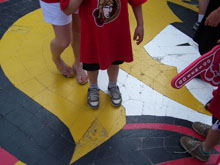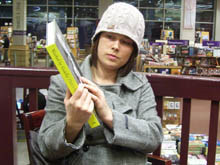
Die Mannequin: Canadian
“Autumn Cannibalist”; ‘How To Kill’ [Digital EP] (2006)
![]()
Canadians think sporting events are so nice we like to watch them twice. And three times. And maybe four in a row. Then sixteen times from every conceivable angle. Okay nineteen is too much. Slowed down. In reverse. Frame by single frame.
And now, thanks to a Canadian named George Retzlaff, the whole world can enjoy Instant Replay. George invented Instant Replay back in 1955 while working for the Canadian Broadcasting Corporation’s (CBC) “Hockey Night In Canada” (HNIC). George used a new “hot processor” technique to develop a kinescope (film) recording of a goal which was then rebroadcast within thirty seconds for “instant” replay.
Every sport played on this earth today — except maybe the “Afghanistan Professional Buzkashi League” — uses George’s Instant Replay in some form.
George was born in Kiel, Germany and moved to Saskatchewan when he was six. In 1953, at the tender age of 30 — and just a few months after CBC started broadcasting — he became head of CBC Sports and producer of HNIC.
He produced and directed HNIC for aboot 20 years and devised many of the techniques and camera angles still used in most televised sporting events around the world today. In 1973, George became the original recipient of hockey’s Foster Hewitt Award for Excellence in Sports Broadcasting. He retired from the CBC in 1984. George died August 5, 2003, survived by seven children from his two marriages, 20 grandchildren and four great grandchildren.
.

.










 0_o
0_o





















damn…your video’s no longer available…
I’m surprised it was available in the first place… NASCAR’s usually pretty hardcore aboot who posts what aboot their races. I’ll find something comparable once I stop having guests.
It’s fixed.
Instant replay is the replaying of video footage of an event or incident very soon after it has occurred. In television broadcasting of sports events, instant replay is often used during live broadcast, to show a passage of play which was important or remarkable, or which was unclear on first sight.
Some sports organizations allow referees or other officials to consult replay footage before making or revising a decision about an unclear or dubious play. This is variously called video referee, video umpire, instant replay official, television match official or third umpire. Other associations allow video evidence only after the end of the contest, for example to penalize a player for misconduct not noticed by the officials during play.
CBS director, Tony Verna, invented a system to enable a standard videotape machine to instantly replay on 7 December 1963, for the network’s coverage of the Army–Navy Game.[1] After technical hitches, the only replay broadcast was Rollie Stichweh’s winning touchdown. It was replayed at the original speed, with commentator Lindsey Nelson advising viewers “Ladies and gentlemen, Army did not score again!”[1]
Marshall McLuhan, the noted communication theorist, famously said that any new medium contains all prior media within it. McLuhan gave Tony Verna’s invention of instant replay as a good example. “Until the advent of the instant replay, televised football had served simply as a substitute for physically attending the game; the advent of instant replay – which is possible only with the television – marks a post-convergent moment in the medium of television.” A 1950s episode of Hockey Night in Canada (HNIC) used a wet-film-replay, minutes later. Slow motion replay was initiated a few years later by ABC.[1] Replay from analog disk storage was trialled by CBS in 1965, and commercialized in 1967 by the Ampex HS-100, which had a 30-second capacity and freeze frame capability.[2]
…so in1963 Tony Verna came up with a way to make instant replay, which was invented in 1955, better. If I ever start a blog about how some people made improvements on other people’s inventions, I’ll definitely keep Tony in mind.
CBS director, Tony Verna, invented a system to enable a standard videotape machine to instantly replay on 7 December 1963, for the network’s coverage of the Army–Navy Game.[1] After technical hitches, the only replay broadcast was Rollie Stichweh’s winning touchdown. It was replayed at the original speed, with commentator Lindsey Nelson advising viewers “Ladies and gentlemen, Army did not score again!”[1]
Marshall McLuhan, the noted communication theorist, famously said that any new medium contains all prior media within it. McLuhan gave Tony Verna’s invention of instant replay as a good example. “Until the advent of the instant replay, televised football had served simply as a substitute for physically attending the game; the advent of instant replay – which is possible only with the television – marks a post-convergent moment in the medium of television.” A 1950s episode of Hockey Night in Canada (HNIC) used a wet-film-replay, minutes later. Slow motion replay was initiated a few years later by ABC.[1] Replay from analog disk storage was trialled by CBS in 1965, and commercialized in 1967 by the Ampex HS-100, which had a 30-second capacity and freeze frame capability.
Yeah, I read your copy-and-paste comment the first time. You can leave it as many times as you want*, but Tony still didn’t invent “instant replay”.
And quoting a Canadian philosopher is not helping your cause. Tony didn’t invent instant replay, he just found another place it could be used.
Instant replay: invented by George Retzlaff in 1955, later modified by a whole lot of people, including some guy at CBS in 1963.
*actually, this is the last time. Copy and paste something new, and relevant, or be marked as a spammer.
Pingback: Oh Canada! 150 Years of Innovation - Volta